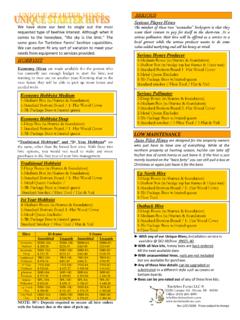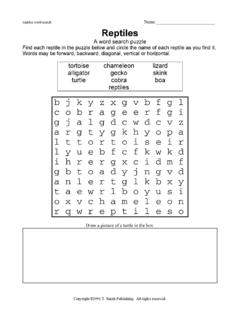Transcription of Murray River Turtle Information Package
1 Murray River Turtle Information Package Prepared by Professor Michael B. Thompson1 and Dr Ricky-John Spencer2 Ricky-John Spencer 2 Academic Course Advisor BSc (Zoology, Environmental Science, Biological Sciences) Senior Lecturer in Zoology Native and Pest Animal Unit School of Science and Health Building M15 University of Western Sydney, Hawkesbury Locked Bag 1797 Penrith, NSW 2751 AUSTRALIA Ph: +61 2 4570 1962 E-mail: Follow us on @eLysNews and @TurtleSAT Professor in Zoology School of Biological Sciences Heydon-Laurence Building (A08) University of Sydney, NSW 2006 AUSTRALIA Phone: +61 2 9351 3989 E-mail: Adjunct Professor Barbara Hardy Institute University of South Australia, GPO Box 2471, Adelaide South Australia 5000 1 Michael B. Thompson 2 Species identification There are three species of turtles in the River Murray in South Australia.
2 Murray short-necked Turtle , Emydura macquarii Also known as thukubi (Ngarrindjeri dictionary) The short-necked Turtle is very abundant and common in open water, including lagoons and the mainstream of the River . Males grow to about kg and females may sometimes exceed kg. They are typically olive green or bronze in colour (Fig. 1) on the carapace and cream underneath. The shell can be stained or covered in green algae or mud. The neck is short relative to the other species. The plastron is narrow and does not cover the legs when they are retracted. Short-necked turtles sometimes bask on logs in the water, but otherwise they rarely come out of the water, except to nest. They probably nest close to where they normally live and usually within 50 m of the water s edge. Nesting time in South Australia is usually from about the second week of November through to Christmas, with eggs taking 6-8 weeks to hatch.
3 Some females lay two clutches of eggs in a season and the clutch size can be up to 30 eggs. Short-necked turtles are omnivorous, eating considerable plant material, as well as invertebrates. They are major consumers of dead animals, cleaning up dead fish and other animals in the water. Currently listed as threatened in Victoria because they are an ageing population. Figure 1. Emydura macquarii. Photo: R. Spencer Check box About the size of a dinner plate Most likely to be seen basking on logs (may just hear a big splash though) Small chunky neck Not on land much, may find them nesting in November 3 Eastern long-necked Turtle , Chelodina longicollis Also known as malinthaipari (Ngarrindjeri dictionary) The Eastern long-necked Turtle is the most widespread Turtle in south-eastern Australia.
4 It lives in any body of water, from the main River , to permanent and temporary fringing wetlands and farm dams. Long-necked turtles are the most terrestrial of the three species, often travelling from one water body to another. Thus, they are commonly killed on the roads. Long-necked Turtle are the smallest of the three species, with males growing to almost 1 kg and females sometimes more than kg. The carapace is typically very dark brown or black (Fig. 2), and the plastron is cream with distinctive black lines along the joins between the scutes of the plastron (Fig. 7,8). The plastron is wide, covering most of the limbs, head and tail when they are retracted. This species releases a distinct, pungent scent from glands on the bridge between the carapace and plastron. Nesting season is predominantly in November and December.
5 The females may walk considerable distances from water, but generally less than 200 m, and many nests are close to water. The eggs take 2-3 months to hatch and the babies have distinct orange or red spots on their plastron (Fig. 3). Long-necked turtles are carnivores, mostly feeding on invertebrates from zooplankton to macro-invertebrates, including yabbies. They will eat dead animals in the water, which means that they can be caught in baited traps. Figure 3. Hatchling Chelodina longicollis. Note the general black colour, except for bright orange or red spots on the plastron. The only species in the Murray with distinctive orange markings. The orgnge spots are lost as the Turtle grows. Note also the umbilical scar, which indicates that this individual hatched recently. Figure 2. Adult female Chelodina longicollis.
6 Note growth of algae on carapace. Photo: Thompson Check box About the size of a bread/side plate Most common species found on land Long, slender neck Distinct black markings on the plastron (underside) Pungent smell when you pick them up 4 Broad-shelled Turtle , Chelodina expansa Also known as weri (Ngarrindjeri dictionary) The broad-shelled Turtle is the largest of the three species and has the longest neck of any Turtle in the world (Fig. 4,9). It is the least common species in the Murray , living only in permanent, deep water. Females may exceed 5 kg in mass and males may reach almost 4 kg. They are easy to tell apart from long-necked turtles because the plastron is narrow and lacks the distinct black lines between the scutes (Fig. 9). The plastron does not cover the legs, head and tail when they are retracted.
7 Broad-shelled turtles nest in autumn, so their nesting time is after the nests of the other species have all hatched. The eggs are much larger than the other species. They nest singly and often quite some distance from the water maybe even more than 500 m. Embryonic development can sometimes be arrested, giving the eggs a very long incubation period of a year of more. Broad-shelled turtles are obligate carnivores that feed mostly on fast swimming prey such as fish and shrimps, but will eat dead animals, as they are captured in traps baited meat. Endangered in Victoria. Figure 4. Adult Chelodina expansa. Note extraordinarily long neck. Photo: H. Stricker Check box About the size of a large platter. Very distinctive when you find one. Least common species found on land Very long, slender neck, flattened head 5 Sexing turtles Generally speaking, female turtles grow larger than males and males have longer tails than females.
8 That is because mating occurs in the water with the male on the top of the female and he has to reach around the female s carapace to insert his penis into her cloaca. The long penis extends from an opening half way down the tail, which extends its total length (Fig. 5). Emydura macquarii and Chelodina expansa easily fit this description, but Chelodina longicollis is much more difficult to sex as the difference in tail length is less than in the other species and the tail is pulled tightly beneath the carapace when the Turtle is picked up. Hatchlings and juveniles are impossible to sex, so they should just be recorded as hatchling or juvenile . Adolescent turtles are often difficult to sex, too. Use your best judgement and, if in doubt, record them as juvenile or your best guess at sex, followed by a ?
9 Emydura macquarii Adult E. macquarii are easily sexed by their size and the length of their tail (Fig. 6). The tail of males is very long, with more than half extending past the end of the carapace, if the tail was extended straight out. The tail of females does extend beyond the carapace, but not much. The cloaca of the male is towards the end of the tail, whereas that of the female is not more than half way along the tail. Tail Penis Figure 5. Extended penis of Emydura macquarii. Note that the cloaca is near the end of the tail. Photo: Thompson 6 Figure 6. Male (top) and female(bottom) Emydura macquarii Note that the plastron is narrow and does not cover the legs. The ventral colour is generally a light olive or cream, although it may be stained brown or rusty coloured. There are no dark lines along the joins between scutes of the plastron.
10 The top photo is a male. Note that the tail is long. If it was straight out from the body, two thirds of it would extend beyond the carapace. The cloacal opening is three quarters of the way to the tip. Females (bottom) have a much smaller tail and the cloaca is approximately halfway to the tip. NB. Do not use shape of plastron to identify sex in this species. Photo: R. Spencer 7 Chelodina longicollis For this species, you need to use the shape of the plastron to identify the sex. Turn the Turtle onto its back. If it is large (larger than 1,000 g) it is almost certainly female. The notch at the back of the plastron in mature females is rounded and in males it is V-shaped . Also, the posterior plastron of females tends to bulge outwards, whereas in males it tends to be concave (Fig. 7,8).






